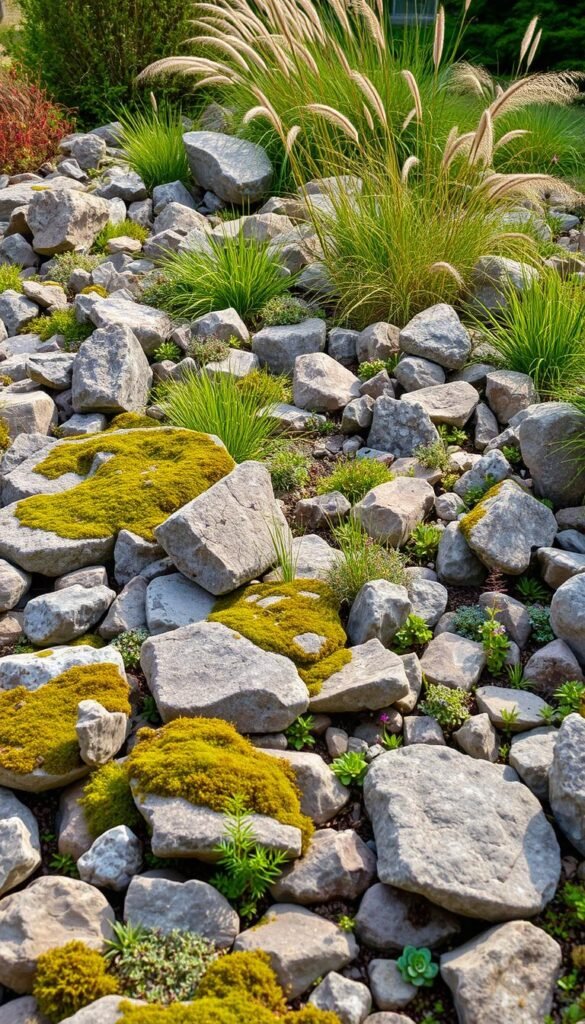Picture transforming your yard into a serene retreat that thrives with minimal effort. Stone features and drought-resistant plants create striking contrasts while requiring little upkeep. This approach blends rugged charm with practical design, perfect for busy homeowners seeking beauty without constant maintenance.
These landscapes adapt to any space, whether you’re working with a sprawling backyard or a cozy corner. Strategically placed boulders and gravel paths add depth, while native grasses or succulents soften the rugged edges. You’ll discover how versatile layouts can solve drainage issues or replace thirsty lawns in dry climates.
The magic lies in mixing textures and sizes. Imagine smooth river rocks beside jagged slate or pebble mosaics weaving through creeping thyme. Every choice reflects your style, from minimalist Zen arrangements to wild, meadow-inspired displays. Even seasonal changes become part of the appeal, with evergreen shrubs or flowering sedums providing year-round interest.
Ready to reimagine your outdoor space? Let’s explore creative ways to craft a landscape that feels both timeless and uniquely yours. You’ll soon see why stone-based designs have become a favorite for eco-conscious gardeners across the U.S.
Introduction to the World of Rock Gardens
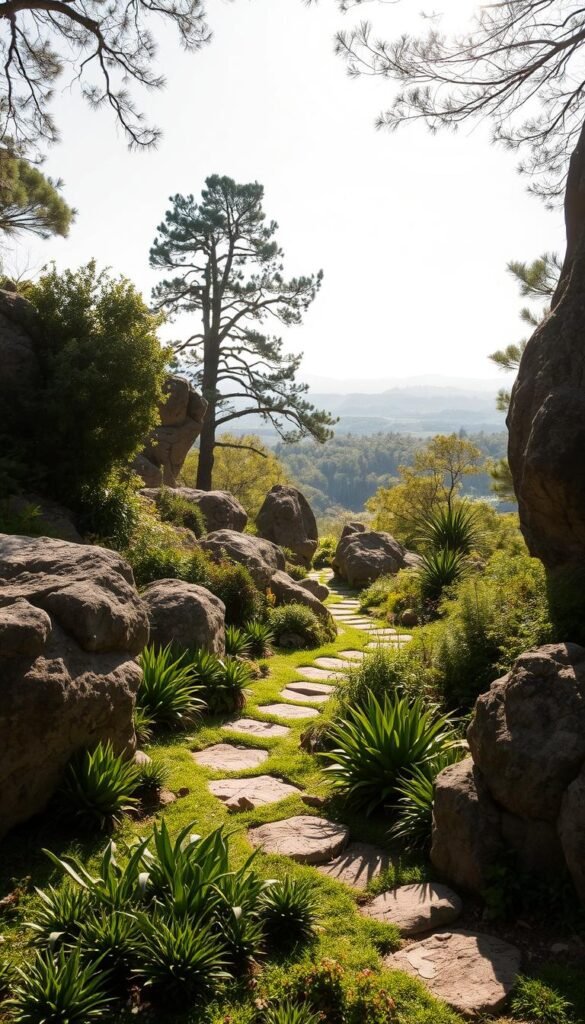
Discover how earth’s raw materials can craft a living masterpiece in your backyard. Unlike conventional layouts, these designs blend rugged stones with resilient plants to create spaces that feel both wild and intentional. Let’s explore why this approach captivates homeowners seeking beauty with purpose.
What Makes This Approach Unique?
Your outdoor space becomes a canvas where nature’s textures take center stage. Drought-tolerant species thrive between stones, reducing water use while adding pops of color. This harmony between hardscape and greenery creates depth that evolves with seasons.
“A well-designed stone layout doesn’t fight the land—it celebrates what’s already there.”
Crafting Your Personal Retreat
Even tricky spots like slopes or clay-heavy soil can become assets. Use angular boulders to prevent erosion or smooth pebbles to guide foot traffic. The table below shows how rock gardens compare to traditional setups:
| Feature | Traditional Garden | Rock Garden |
|---|---|---|
| Water Needs | High | Low |
| Maintenance | Weekly care | Seasonal touch-ups |
| Plant Choices | Limited by soil | Adapts to conditions |
You’ll love how versatile layouts turn problem areas into focal points. Whether you prefer clean lines or free-form clusters, the structure lasts for years with minimal fuss.
Benefits and Charm of Rock Garden Design
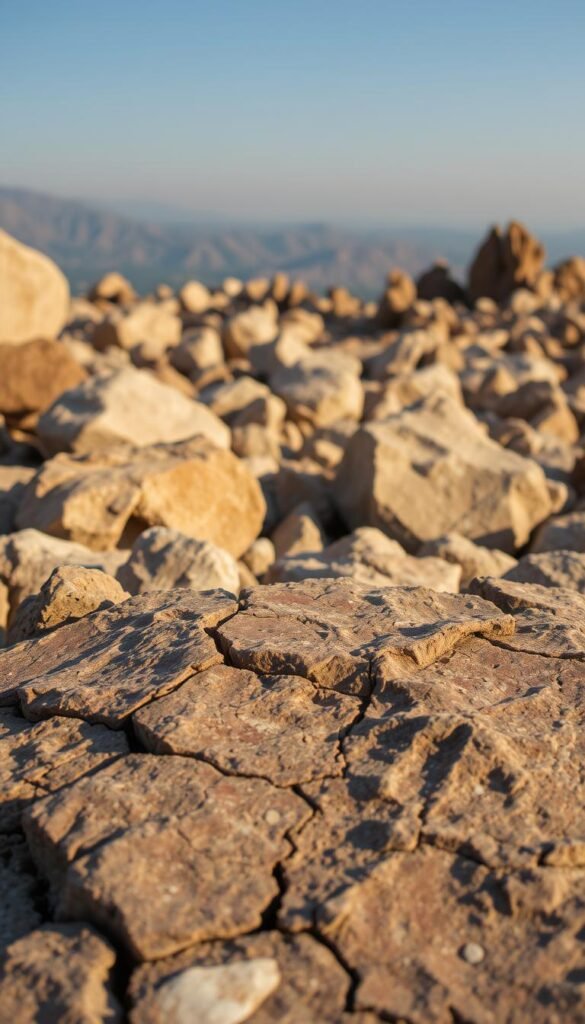
Stone arrangements bring a special magic to outdoor spaces that keeps neighbors peeking over fences. These layouts turn ordinary yards into conversation starters through smart combinations of natural elements and practical perks.
Nature’s Artistry at Work
Your space gains visual interest through layered stone placements. Mix angular slate chips with rounded cobblestones to create movement that draws the eye. Texture variations become design features when you pair feathery grasses with polished pebble accents.
Smart Solutions for Modern Living
These landscapes shine as low-maintenance alternatives to high-effort lawns. Once established, they thrive through summer heat and winter chills without constant care. Check how they stack up against conventional gardens:
| Aspect | Typical Lawn | Stone Layout |
|---|---|---|
| Water Needs | 50 gallons/week | 5 gallons/week |
| Weeding Frequency | Every 10 days | Seasonal |
| Soil Requirements | Specific pH | Adapts Naturally |
You’ll save weekends previously spent mowing or fertilizing. Native plants nestled between stones attract pollinators while needing minimal trimming. It’s a great way to boost curb appeal without hiring landscapers.
Seasonal changes highlight different strengths – snow-dusted boulders in January, blooming sedums in July. Your stone design becomes a living sculpture that evolves through the years, always fresh yet timeless.
Planning Your Dream Outdoor Rock Garden
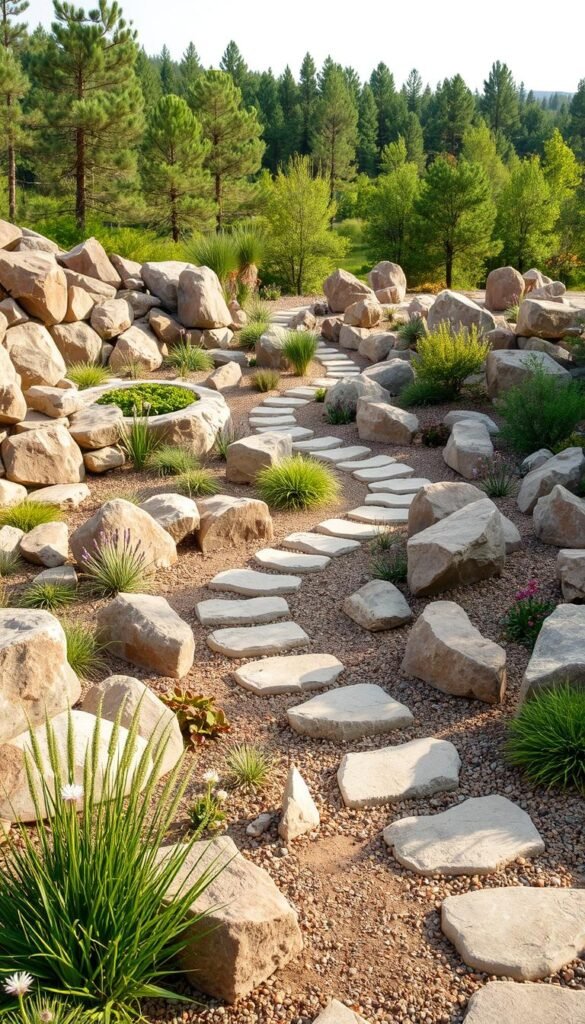
Creating your ideal stone landscape starts with smart groundwork. You’ll want to balance practical needs with creative vision, transforming ordinary spaces into eye-catching displays. Let’s break down how to set the stage for success.
Choosing the Ideal Site
Sunlight patterns make or break your layout. Observe how shadows move across your backyard during peak growing seasons. Sloped areas become assets when paired with cascading plants, while flat spaces suit geometric arrangements.
Drainage matters most. Test how water flows after rainstorms—low spots might need gravel bases. Use this quick guide to compare site types:
| Site Feature | Best Use | Plant Pairings |
|---|---|---|
| Full Sun | Succulent clusters | Sedum, hens-and-chicks |
| Partial Shade | Mossy accents | Irish moss, creeping phlox |
| Steep Slope | Erosion control | Junipers, ornamental grasses |
Evaluating Materials and Layout Options
Mix stone sizes for visual rhythm. Place larger boulders first as anchors, then fill gaps with mid-sized rocks. Leave breathing room for plants to spread—they’ll soften edges naturally over time.
Sketch multiple versions on graph paper. Consider how design elements like winding paths or DIY garden art projects might enhance your theme. Remember: maintenance access matters as much as aesthetics.
Visit your chosen spot at dawn, noon, and dusk. Notice how light plays across surfaces—this helps position focal points. Your final layout should feel intentional yet effortless, like nature arranged it herself.
Essential Tools and Materials for a Rock Garden
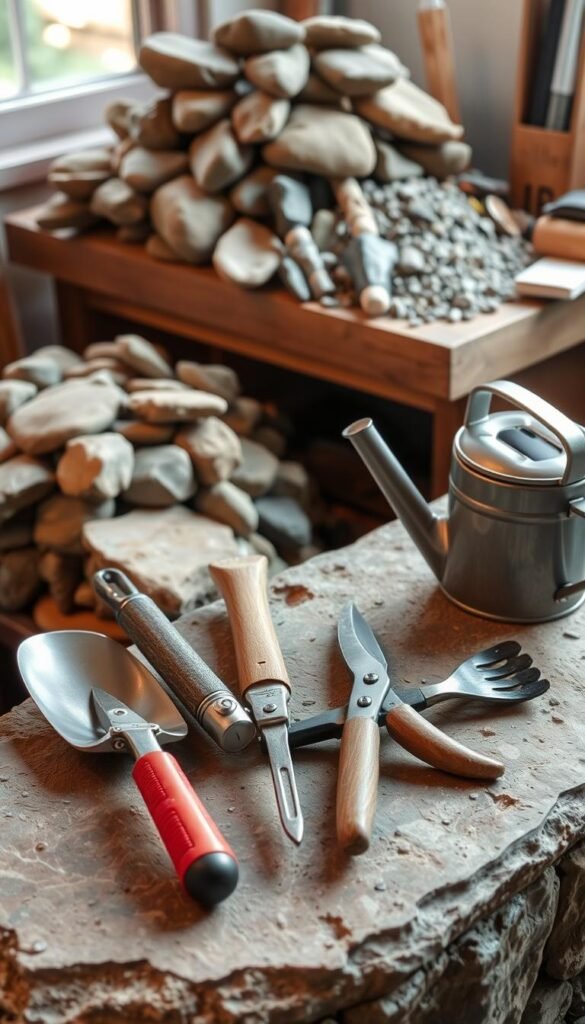
Building a stone landscape begins with gathering the right resources. You’ll need three core components: quality rocks, proper soil, and resilient plants. Smart material choices ensure your design looks cohesive while standing up to weather changes.
Selecting the Right Rocks and Stones
Your stone palette sets the tone. Mix sizes for visual balance—large boulders anchor spaces, while smaller pieces fill gaps. Match colors to nearby features like your home’s exterior or existing plants.
| Rock Size | Purpose | Example Stones |
|---|---|---|
| 12-24″ | Focal points | Sandstone, limestone |
| 6-12″ | Transition areas | Slate chips, river rocks |
| 1-3″ | Ground cover | Pea gravel, crushed granite |
Local quarries often offer the best rock options—they blend naturally with regional terrain and cut shipping costs. Always check stone weight limits for your space.
Must-Have Gardening Tools
Proper equipment saves time and prevents injuries. Start with these essentials:
- Heavy-duty shovel for moving earth
- Wheelbarrow with pneumatic tires
- Landscape fabric to suppress weeds
- Trowel and cultivator for tight spaces
“Quality gloves and safety glasses aren’t optional—they’re your first defense against sharp edges,” notes Colorado landscaper Mia Torres.
Add gravel for drainage and edging materials to define borders. With these tools, you’ll transform raw materials into a polished, low-maintenance retreat.
Understanding the Different Types of Rock Gardens
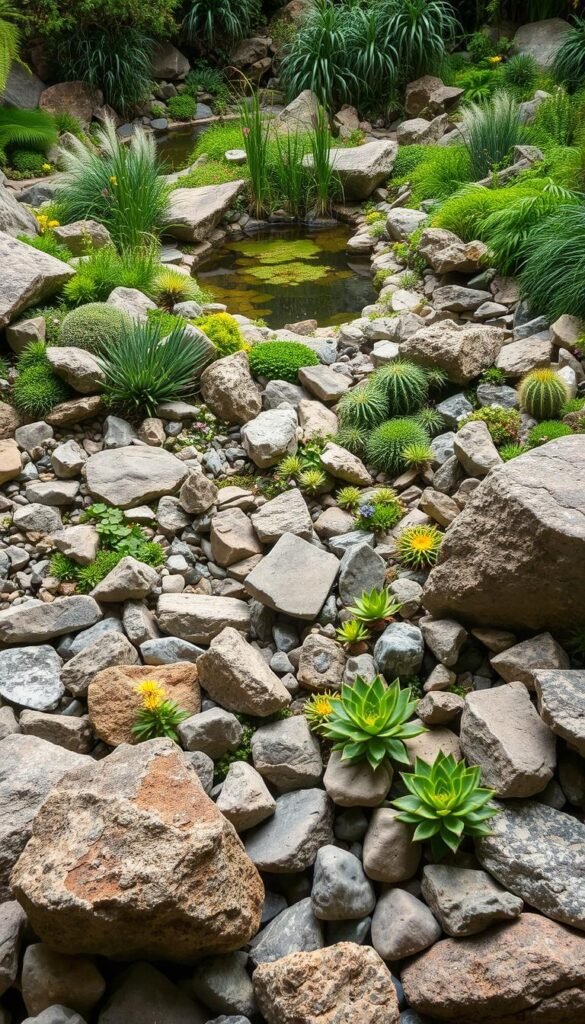
Transform your landscape with four distinct approaches to stone-based designs. Each style brings unique character through thoughtful combinations of geology and greenery. Let’s explore how these variations can align with your environment and aesthetic goals.
Alpine Stone Landscapes
Channel mountain energy with rugged boulders and hardy plants like saxifrage or creeping phlox. These arrangements thrive in sloped areas, using elevation changes to create natural drama. You’ll love how wind-swept grasses peek through crevices, mimicking high-altitude ecosystems.
Zen-Inspired Spaces
Create meditative zones with raked gravel patterns and minimalist stone placements. Strategic simplicity defines these layouts—think single moss-covered rocks surrounded by swirling sand. “The empty spaces matter as much as the stones,” notes Japanese garden designer Hiroshi Nakamura.
Desert Oasis Designs
Warm-toned gravel and agave plants form the backbone of these low-water layouts. They excel in sunny spots where cacti and succulents add sculptural interest. You’ll appreciate how decomposed granite pathways blend seamlessly with terracotta pots.
Woodland Retreats
In shady corners, combine fern-covered stones with decaying logs for an enchanted forest vibe. Moss acts as living carpet between stepping stones, while hostas provide lush foliage contrasts. These spaces feel cool and mysterious even on hot summer days.
| Style | Key Features | Best For |
|---|---|---|
| Alpine | Sloped terrain, cold-hardy plants | Mountain regions |
| Zen | Minimalist patterns, meditation spaces | Small urban yards |
| Desert | Drought-resistant species, warm colors | Arid climates |
| Woodland | Shade plants, organic materials | Forest-edge properties |
Your local climate and personal style will guide the perfect choice. Whether crafting a tranquil Zen corner or a wild Alpine slope, these designs prove stone landscapes offer endless creative possibilities.
10 Rock Garden Ideas for a Natural, Textured Look

Unlock your yard’s potential with stone arrangements that solve practical challenges while boosting curb appeal. These concepts blend rugged materials with clever planting strategies to create spaces that feel both intentional and effortlessly wild.
Flat stepping stones make excellent natural staircases on slopes. They guide foot traffic while blending into the landscape. Pair them with creeping thyme or sedum for soft edges that withstand heavy use.
Create dry riverbeds using blue-gray stones arranged in winding patterns. This optical illusion adds movement without water maintenance. Border them with drought-tolerant grasses for a realistic riparian effect.
- Ice plants carpet rocky areas in magenta blooms, thriving where other plants struggle
- Smooth pebble paths contrast beautifully with jagged boulders, adding tactile interest
- Colorful succulents like echeveria create living mosaics in crevices between stones
Zen-inspired spaces use raked gravel to mimic water ripples around anchor stones. “The empty areas encourage mindfulness as much as the rocks themselves,” notes landscape artist Mara Lin. Terraced designs turn steep slopes into eye-catching displays, each level showcasing different stone textures.
Lava rocks bring volcanic drama with their porous surfaces and rust-red hues. They’re perfect for modern xeriscapes or as mulch around agaves. For ultimate tranquility, add a recirculating waterfall using stacked slate – the sound masks street noise while attracting birds.
Each concept adapts to your space’s unique conditions. Whether crafting a desert oasis or woodland retreat, these approaches prove stone landscapes offer endless creative solutions.
Integrating Natural Water Features and Rock Elements
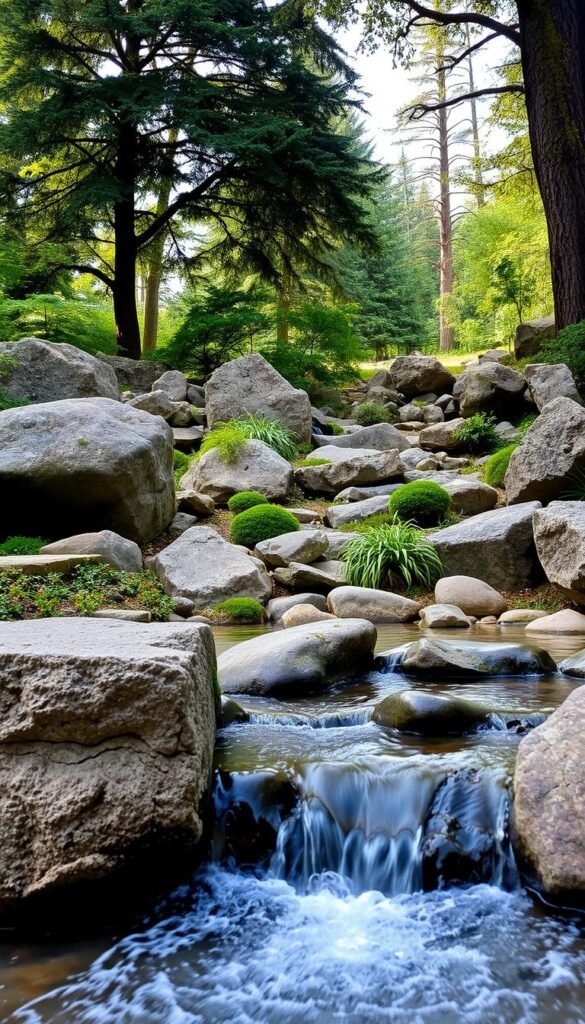
Water and stone form an ancient partnership that transforms ordinary spaces into living ecosystems. These combinations add movement and reflection to your landscape while solving practical challenges like poor drainage. Let’s explore how liquid and mineral elements can work together.
Incorporating a Pond or Waterfall
Imagine a still pool reflecting surrounding boulders like nature’s mirror. You’ll want irregularly shaped stones around the edges to mimic weathered shorelines. Vary depths from shallow shelves to deeper zones—this creates habitats for water lilies and fish.
For cascading effects, stack flat rocks to form natural-looking ledges. The sound of tumbling water masks traffic noise while cooling summer air. Pro tip: Use submerged pumps hidden behind strategic stone placements for seamless circulation.
Creating the Illusion of a Flowing River
No stream? No problem. Arrange blue-gray stones in winding paths that narrow and widen like real waterways. Place larger rocks along “banks” to suggest erosion patterns. Add rounded pebbles in the center to imitate smoothed riverbed stones.
Consider these elements for dry riverbeds:
- Oval-shaped boulders as resting points
- Moss between gaps for aged authenticity
- Sloped gravel beds directing rainwater
“A well-designed dry stream looks thirsty—like it’s waiting for the next storm,” observes Arizona landscaper Diego Marquez.
Both water features become wildlife magnets. Dragonflies hover over ponds, while birds bathe in shallow edges. Just ensure proper drainage slopes and filtration systems to keep your living water features healthy and clear.
Designing Creative Pathways and Walkways
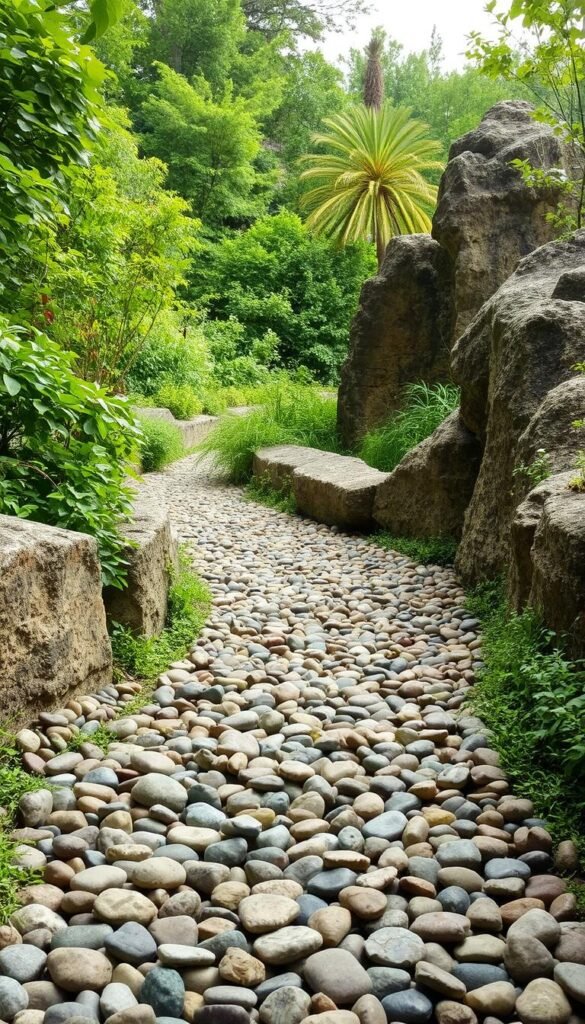
Paths become the veins of your landscape, guiding movement while enhancing visual flow. Thoughtful designs balance functionality with artistic flair, turning practical routes into design statements.
Stone Solutions for Every Step
Pebble paths offer soothing textures underfoot. Their rounded shapes contrast beautifully with angular boulders, creating natural rhythm. Space flat stepping stones 18-24 inches apart—this mimics a relaxed walking pace while showcasing plants between gaps.
Consider these materials for different effects:
| Material | Benefits | Best For |
|---|---|---|
| Pea Pebbles | Soft texture, drainage | Curving paths |
| Flagstones | Stable surface | High-traffic areas |
| Crushed Gravel | Rustic crunch | Country-style spaces |
| Mixed Sizes | Visual drama | Focal points |
Connect your backyard zones with winding routes. A meandering pathway past lavender bushes feels more inviting than a straight line. “Make visitors want to explore what’s around the bend,” suggests Oregon designer Ellie Tanaka.
Maintenance matters too. Keep paths 36 inches wide for easy mowing access. Edge with larger stones to prevent gravel spillage. You’ll love how these practical touches keep your space looking crisp without constant upkeep.
Enhancing Your Garden with Mixed Textures and Shapes
Your outdoor space gains depth when rough meets refined. Contrasting stone surfaces create tactile interest that invites touch while adding visual structure. This approach turns ordinary layouts into dynamic compositions that feel both wild and intentional.
Balancing Scale and Surface
Start with anchor boulders that command attention. Their rugged edges pair beautifully with smooth river rocks or polished pebbles. Place smaller stones in clusters around these focal points to guide the eye naturally.
Try slate chips near feathery grasses for soft-hard contrasts. Moss-filled gaps between stepping stones add organic charm. Even color variations matter—warm sandstone pops against cool granite slabs.
“Texture contrast prevents monotony,” notes Utah landscaper Clara Rhodes. “A jagged limestone edge beside rounded gravel creates movement without plants.” Remember to leave space for drought-resistant ground covers that soften edges over time.
Your design will evolve as weather and growth add patina. What begins as deliberate placement becomes a living artwork shaped by nature’s hand.

